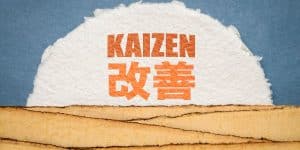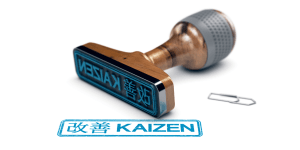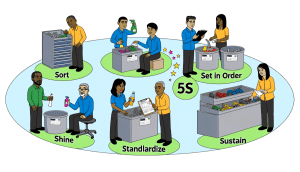Mura is a term used in Lean methodology to describe variability or unevenness in operations. It is one of the three types of waste (Muda, Mura, Muri) that Lean seeks to eliminate.
Mura has its origins in the Toyota Production System, where it was identified as a source of inefficiency and waste. Toyota developed techniques to reduce Mura and improve process flow.
Addressing Mura is important in modern business processes because it helps to improve efficiency, reduce waste, and enhance product quality and consistency. By identifying and reducing variability in operations, businesses can achieve more consistent results and better utilize their resources.
Pros of Addressing Mura
Improved process efficiency and reduced waste. By eliminating fluctuations and unevenness in the production process, businesses can optimize their capacity and avoid overproduction, inventory build-up, or downtime. This leads to lower costs, higher profits, and less environmental impact.
Enhanced product quality and consistency. By standardizing the process and reducing variation, businesses can ensure that their products meet the specifications and expectations of their customers. This leads to higher customer satisfaction, loyalty, and retention.
Better resource allocation and workload distribution. By balancing the workloads and demands across the process, businesses can prevent bottlenecks, overburdening, or idle time for their workers and machines. This leads to improved employee morale, productivity, and safety, as well as better maintenance and utilization of equipment.
Cons of Addressing Mura
Challenges in identifying and measuring Mura. Unlike Muri and Muda, which are more visible and quantifiable, Mura is often subtle and subjective. It may not be easy to detect or measure the variations and inconsistencies in a process, especially if they are caused by external factors or human behaviours. Therefore, businesses need to have reliable data collection and analysis methods, as well as clear and consistent standards and criteria, to identify and measure Mura effectively.
Potential resistance to change in established processes.
Addressing Mura may require changing the existing processes, routines, and habits of the workers and managers, which can cause resistance or reluctance. Some people may prefer to stick to the familiar ways of doing things, or fear that the changes will affect their performance or compensation. Therefore, businesses need to communicate the benefits and rationale of addressing Mura, as well as provide adequate training and support, to overcome the resistance and foster a culture of continuous improvement.
The need for continuous monitoring and adjustment.
Addressing Mura is not a one-time event, but an ongoing process that requires constant monitoring and adjustment. Businesses need to keep track of the changes and outcomes of addressing Mura, as well as anticipate and respond to the fluctuations and uncertainties in the market and customer demands. Therefore, businesses need to have flexible and agile processes, as well as feedback and evaluation mechanisms, to ensure that they can adapt and improve their processes continuously.
Real-World Examples of Mura
In this section, we will provide some real-world examples of how addressing Mura can lead to significant improvements in various industries, as well as how failure to address Mura can cause issues and inefficiencies.
Toyota
One of the most well-known examples of addressing Mura is Toyota, the Japanese car manufacturer that pioneered the Lean production system. Toyota recognized that unevenness in production and demand can cause waste, overburden, and quality problems, and developed several methods and tools to eliminate Mura, such as:
The pull system: a production method that only produces what is needed by the customer, when it is needed, and in the amount needed, thus avoiding overproduction and inventory.
Heijunka: a production leveling technique that balances the type and quantity of products produced over a period of time, thus avoiding fluctuations and bottlenecks.
Kanban: a visual signaling system that triggers the flow of materials and information between different processes, thus avoiding delays and shortages.
Kaizen: a continuous improvement philosophy that involves everyone in the organization in identifying and solving problems, thus avoiding complacency and stagnation.
By addressing Mura, Toyota was able to achieve high levels of efficiency, quality, customer satisfaction, and profitability, and become one of the world’s leading car manufacturers.
Amazon
Another example of addressing Mura is Amazon, the American e-commerce giant that dominates the online retail market. Amazon faced the challenge of delivering millions of orders to customers around the world, with varying demand patterns and expectations.
To address Mura, Amazon implemented several strategies and innovations, such as:
Dynamic pricing: a pricing strategy that adjusts the prices of products based on supply and demand, customer behaviour, and competitors’ prices, thus optimizing revenue and customer retention.
Fulfilment by Amazon (FBA): a service that allows sellers to store their products in Amazon’s warehouses and let Amazon handle the picking, packing, shipping, and customer service, thus reducing the burden and cost for the sellers and increasing the speed and convenience for the customers.
Amazon Prime: a subscription program that offers customers free and fast shipping, as well as access to other benefits such as video streaming, music streaming, and e-books, thus increasing customer loyalty and spending.
Amazon Web Services (AWS): a cloud computing platform that provides on-demand computing, storage, and networking services to businesses and individuals, thus reducing the need for physical infrastructure and enabling scalability and flexibility.
By addressing Mura, Amazon was able to create a competitive advantage and a loyal customer base and become one of the world’s most valuable companies.
Walmart
A counterexample of addressing Mura is Walmart, the American retail giant that operates thousands of stores across the globe. Walmart faced the problem of unevenness in its inventory management, which resulted in excess inventory, stockouts, and lower sales. One of the causes of this problem was Walmart’s reliance on manual ordering systems, which were prone to human errors, delays, and biases. Another cause was Walmart’s lack of communication and coordination with its suppliers, which led to mismatched expectations and delivery times. To address Mura, Walmart needed to adopt more automated and integrated systems, such as:
Retail Link: a data-sharing system that connects Walmart’s point-of-sale data with its suppliers, thus enabling them to monitor the inventory levels and sales trends of their products and adjust their production and delivery accordingly.
Vendor Managed Inventory (VMI): a supply chain management practice that allows the suppliers to manage the inventory of their products at Walmart’s stores, thus reducing the need for manual ordering and increasing the availability and replenishment of the products.
Radio Frequency Identification (RFID): a technology that uses radio waves to identify and track objects, such as products, pallets, and containers, thus improving the visibility and accuracy of the inventory and reducing the losses and thefts.
By addressing Mura, Walmart could improve its inventory efficiency, customer satisfaction, and profitability, and maintain its leadership position in the retail industry.
Strategies to Make the Most of the Mura Principle
Mura, or unevenness, is one of the three types of waste (Muda, Mura, and Muri) that lean manufacturing aims to eliminate. Mura occurs when there is variation in the demand, supply, or flow of a process, resulting in overburdening or underutilizing the resources. Mura can lead to defects, delays, excess inventory, and customer dissatisfaction.
To make the most of the Mura principle and achieve more consistent and efficient processes, the following strategies can be applied:
Techniques for identifying Mura in processes: One of the first steps to reduce Mura is to identify where it exists and what causes it. This can be done by using various tools and techniques, such as value stream mapping, process flow analysis, Pareto charts, histograms, control charts, and root cause analysis. These methods can help visualize the current state of the process, measure the variation and performance, identify the sources of Mura, and prioritize the improvement actions.
Lean tools and methods for reducing Mura, such as Heijunka (level scheduling): After identifying Mura, the next step is to implement solutions that can reduce or eliminate it. Lean manufacturing offers a variety of tools and methods for this purpose, such as Heijunka, Kanban, pull systems, JIT (just-in-time), Kaizen, Poka-yoke, standard work, and 5S. One of the most effective methods for reducing Mura is Heijunka, which means level scheduling. Heijunka is a technique that balances the production volume and mix according to the customer demand, by smoothing out the fluctuations and variations in the process. Heijunka can help reduce inventory, improve quality, increase flexibility, and enhance customer satisfaction.
The role of leadership and culture in effectively managing Mura: Reducing Mura is not only a technical challenge, but also a cultural and organizational one. To achieve sustainable results, it is essential to have a strong leadership commitment and a culture of continuous improvement. Leaders should communicate the vision and goals of eliminating Mura, provide the necessary resources and support, empower the employees, and reward the achievements. Employees should be engaged and motivated to participate in the improvement activities, learn from the best practices, share the feedback, and embrace the change. By creating a culture of lean thinking and collaboration, Mura can be minimized, and excellence can be achieved.
Conclusion
Mura is one of the three types of waste that lean manufacturing aims to eliminate, along with Muda (non-value-adding activities) and Muri (overburden). Mura refers to unevenness or inconsistency in the production process, which can cause fluctuations in quality, delivery, and customer satisfaction. Mura can be caused by internal or external factors, such as demand variation, machine breakdown, material shortage, or human error. To identify and measure Mura, various tools and techniques can be used, such as value stream mapping, takt time analysis, line balancing, and cycle time variation. By detecting Mura, the root causes of the problems can be found and addressed.
This article discussed how to use lean tools and methods for reducing Mura, such as Heijunka, which is a technique that balances the production volume and mix according to the customer demand, by smoothing out the fluctuations and variations in the process. It also explained the role of leadership and culture in effectively managing Mura, by creating a vision, providing support, empowering employees, and fostering a culture of continuous improvement. By eliminating Mura, the production process can become more stable, efficient, and responsive, which can lead to higher quality, lower cost, and better customer satisfaction.
Recognizing and addressing Mura is crucial for achieving lean transformation, as it can help eliminate the other two types of waste, Muda and Muri, as well. Mura is often the hidden source of inefficiency and variability that undermines the performance and profitability of the organization. By applying the principles and practices of lean manufacturing, Mura can be minimized, and the production process can be optimized. This can result in improved competitiveness and sustainability for the organization in the long run.









